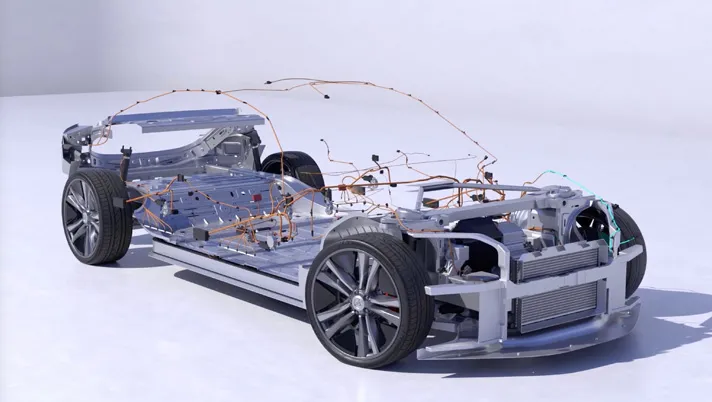The Future of Connected Mobility: Enriching the Customer Experience
Synchronize the development of physical vehicles and virtual end-user experiences to enhance sales and customer satisfaction.
Digital Transformation Drives Value for Manufacturers and Customers
Vehicle design traditionally prioritized customer comfort, but technological advancements are reshaping the automotive industry, blending physical and virtual experiences. Personalization, autonomous driving, sustainability, and safety are advancing rapidly, offering unique driving experiences tailored to each customer's lifestyle.
However, without an effective data-sharing pipeline between design, engineering, and marketing teams, a manufacturer's ability to enhance its relationship with customers may be hindered. The 3DEXPERIENCE® platform ensures that innovation and quality work in tandem, using the Virtual Twin to connect departments and create meaningful customer experiences throughout product development and beyond. Product storytelling is elevated through high-quality images, movies, AR/VR experiences, and integrated apps.

Connected Mobility Solutions
In the dynamic landscape of connected mobility solutions, technological innovations are propelling us into an era of unprecedented convenience and efficiency. As vehicles become increasingly interconnected, leveraging advanced communication technologies, the exchange of data between vehicles, infrastructure, and users is fostering a seamless transportation ecosystem. From smart traffic management systems that optimize routes to autonomous vehicles enhancing safety and reducing congestion, connected mobility is revolutionizing the way we move.
The integration of Internet of Things (IoT) devices and artificial intelligence not only enables real-time data analysis but also facilitates predictive maintenance, ensuring vehicles operate at peak performance. Moreover, the concept of the Virtual Twin, a digital replica of the physical environment, is enhancing decision-making processes by simulating scenarios, predicting outcomes, and offering insights for better-informed choices.
This interconnected web of technological marvels promises a future where transportation is not just a means of reaching a destination but a harmonized experience that prioritizes sustainability, safety, and personalized convenience.
Automated Mobility, Connected Vehicles & Tech
This transformative concept is at the forefront of revolutionizing transportation, ushering in a future where vehicles seamlessly navigate the roads with minimal human intervention.
- Make way for Automated Mobility
- How do Connected Vehicles Work?
- Tethered vs. Embedded Integration
- Bosch Connectivity in Cars

Make way for Automated Mobility
Automated mobility refers to the integration of autonomous technologies in vehicles, enabling them to operate without human intervention. These vehicles leverage advanced sensors, artificial intelligence, and connectivity to navigate, make decisions, and interact with the environment.
Automated mobility promises increased safety, reduced traffic congestion, and improved efficiency by optimizing routes and responding to real-time data.

How do Connected Vehicles Work?
Connected vehicles use IoT and V2X tech for real-time data exchange with other vehicles and the cloud. Equipped with sensors, they share speed, location, and status, enhancing traffic management, safety, and enabling autonomous driving. Cloud connectivity enables updates, remote diagnostics, and builds a cohesive transportation ecosystem for optimized efficiency, convenience, and road safety.

What is the difference between tethered and embedded?
In connected mobility, tethered devices connect externally, often through smartphones, for data exchange. Embedded devices have built-in connectivity, operating independently, ensuring seamless communication. This distinction affects flexibility, complexity, and autonomy, influencing factors like scalability, reliability, and user experience in connected mobility solutions.

Bosch Connectivity in Cars
Bosch Car Multimedia explores the vast potential of connectivity to enhance vehicle safety, efficiency, and entertainment. The company envisions a "travel space" as a third living environment, focusing on infotainment systems and networking solutions. Overcoming challenges, they emphasize collaborative efforts to create holistic digital models for efficient and faster development in the era of rising connectivity.
Sustainability Embedded in the Brand
Dassault Systèmes 3DEXCITE provides manufacturers with an integrated solution to optimize engineering data, allowing it to be repurposed for impactful mobility services. Employing a digital pipeline reduces waste in physical resources and workforce, creating an efficient and streamlined value stream across design, manufacturing, and marketing.
This holistic approach invites customers into the brand, benefiting both the customer and the world. The virtual value stream collaboration is seamless, ensuring the security of IP-protected data. Flexible product customization fosters a sense of belonging for customers, all starting with the Virtual Twin.
The seamless integration of technology and transportation is reshaping our world in the promising future of connected mobility. In the realm of connected mobility, Virtual Twin as a Service (VTaaS) offers distinct advantages. It allows for realistic simulations of traffic scenarios, contributing to the development and testing of autonomous vehicles and intelligent traffic management systems. VTaaS enhances predictive maintenance, identifying potential issues in vehicles and infrastructure before they occur.
It facilitates continuous improvements by analyzing real-time data from connected vehicles, optimizing routes, and improving overall transportation efficiency. The service also aids in the development of personalized mobility solutions, tailoring services to individual preferences. VTaaS acts as a powerful tool for innovation, fostering a more connected, efficient, and user-centric future in the world of mobility.
Driving the Future: Virtual Twins and Software-Defined Vehicles
Learn more and explore how vehicle manufacturers embrace and benefit from digital transformation.